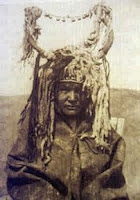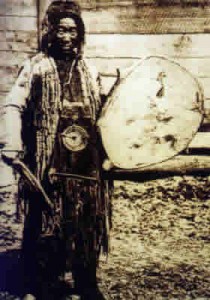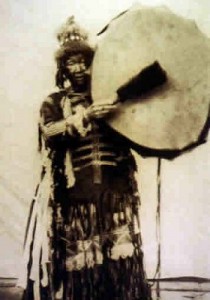In the previous post, I claimed that hallucinogenic plants and fungi have been used in shamanism only in a particular culture area, radiating out from the Upper Amazon, primarily westward into the Andes, northward into Central America and Mexico, and eastward into Brazil. Claims to the contrary — that hallucinogen use underlies most shamanisms both diachronically and synchronically — often turn on the purported use of the hallucinogenic fly agaric mushroom Amanita muscaria by Siberian shamans.
 |
This focus is frequently based on three assumptions — that Siberian shamanism is somehow older and its recent practice somehow purer than shamanisms found elsewhere; that Siberian practices since, say, the seventeenth century, when they were first observed by Europeans, therefore represent shamanic practices dating back tens of thousands of years; and that these ancient practices, carried into the present day, include the use of hallucinogenic mushrooms.
It ought not be necessary to point out that, by the time the first European travelers brought home descriptions of Siberian shamanism, it had already been influenced by centuries of contact with Buddhism, Islam, and Russian Orthodox Christianity. And there is reason to doubt the widespread use of hallucinogenic mushrooms even in contemporary Siberian shamanic practice.
The ascription of Siberian shamanic performances to the use of psychoactive substances was apparently first made in 1939, by Swedish academician Åke Ohlmarks, who pointed specifically to the hallucinogenic fly agaric mushroom which, he claimed, was used by shamans all across Siberia. The idea was extended by Hungarian scholar János Balázs, who suggested that Siberian shamans generally had depended on psychoactive substances for trance induction.
This claim was opposed by Anna-Leena Siikala, an expert in Northern Eurasian shamanism, who asserted that hallucinogens were not “essential to or even a vital factor in the shaman’s trance technique.” And the claim does appear inflated, for several reasons. Fly agaric use has been attributed only to two relatively small regions in Siberia, and the number of shamans reported to use the mushroom in shamanizing has been small.
 |
Ronald Hutton, an unusually insightful and levelheaded historian, has reviewed the Siberian material. He points out that Balázs counted among psychoactive substances such things as inhaling steam, smudging with aromatic herbs, smoking tobacco, and drinking alcohol. “None of these cases can be treated as very convincing,” Hutton writes. “At best, all these substances seem only to have enhanced an effect created far more obviously by the dynamics of the performance itself.” As far as fly agaric is concerned, Balázs relies on a report by Finnish ethnographer K. F. Karjalainen that Khant shamans along the Irtysh and Tsingala rivers used the mushroom to induce trance; but Balázs neglected to quote the comment by the investigator that this seemed to be a recent and inessential technique. Hutton notes other inconsistent reports — that the Selkups used to eat the mushrooms before performing, but now did so only rarely; that, among the Kets, shamans would eat fly agaric, but in order to prove they could eat poison and survive, not to shamanize; that shamans among the Enets sometimes used the mushrooms.
Over against this material, Hutton cites other studies, including a comprehensive study of shamanism among the Khants and Mansi, which concluded that eating mushrooms was one option out of many trance induction techniques, including drumming, dancing, smoking, and staring at a candle; and one of the Khoryaks, which reported that ordinary people took fly agaric in order to attain visions like those of shamans, who apparently did not need it.
Hutton concluded that Siikala was right — that “drugs were not the central features of North Asian shamanism that they have been in South American ritual practices.”
 |
In this regard, Shaman’s Drum magazine published a report of an informal mycological field trip to Kamchatka, which speaks of meeting an eighty-two-year-old shaman, Tatiana Urkachan. The shaman was willing to lecture her visitors on the correct use of fly agaric for healing and intoxication, but she insisted — tellingly — that she never ingested the mushroom herself, for she was too powerful a shaman to need it.
There is also a practical matter. Small doses of fly agaric mushroom produce mild euphoria, suppression of fear, and feelings of increased strength or stamina; doses large enough to cause hallucinations — which in fact occur only rarely and sporadically — are physically incapacitating, with effects including drowsiness, confusion, muscle twitches, loss of muscular coordination, and stupor. It is difficult to see how a shaman could put on a physically demanding shamanic performance under such circumstances. Indeed, the mushrooms have been more widely used outside of shamanism — to get a glimpse of what the shamans see, to prepare for all-night bardic performances, to alleviate the fatigue of heavy labor, or for recreational inebriation at weddings and feasts.

- Previous Post: The Hallucinogen Culture Area
- Next Post: Hallucinogens in North America
- More Articles Related to: Sacred Plants, Shamanism



dont forget papau new guinea…
africa
all over asia
nepal
india
autrialia
europe
all over the world honestly they have been worked with.
Hey LLB!
I wish I knew those cultures better. But the question, for me, is not whether hallucinogens are used all over — I have no doubt they are — but whether they are used for *shamanizing*. All I can say is that I have looked at the major examples that have been brought forward of shamanic use outside what I have called the extended Upper Amazon hallucinogen culture area, and I have not been convinced. And I find that a lot more interesting than if things were the same everywhere. :-)
Hi Steve,
Liked your article and have to say that there’s only one group I’m aware of that uses mushrooms in Siberia – and the whole community uses them – today. One group, the Udegei, say they learned to eat mushrooms from the Russians and don’t seem to remember using them long ago. Every other group I met made no reference to shamans using mushrooms.
In spirit,
Marilyn Walker, PhD
Marilyn —
It is great to hear from you! I am delighted to get some confirmation fom someone who is — unlike me — genuinely knowledgeable in this area. I hope you are having a wonderful summer.
— Steve
Greetings,
I found your post while doing some reasearch on ‘soma’ the holy plant of the Hindus. I just read an interesting article that identifies the plant with the fly agaric mushroom. Perhaps the tradition of using this plant is very old, and was shared through the drinking of urine. The thought was that the body filtered out some of the harmful chemicals and made it safer and perhaps more potent. I’ll admit that it sounds kind of yucky to a Westerner like me, but apparently it isn’t culturally unknown in the East. It’s also interesting that this red/white mushroom is a frequent Germanic child’s illustration accompanying elves and other worldly beings.
The article:
“The Soma of the Rig Veda: What Was It?” by R. Gordon Wasson
Journal of the American Oriental Society, Vol. 91, No. 2 (Apr. – Jun., 1971), pp. 169-187
Katherine in Oregon
Great article. Psychedelics are the source of shamanism, true religion, spirituality, and probably self-awareness, in general. It’s almost impossible to separate the mystical from a true psychedelic experience. The loss of this connection in modern culture is a part of the source of our problem connecting with ourselves, others, and the nature of our being.
Much Love.
My independent study of the cult of the mushroom was inspired by a theory first proposed by my father, the late Maya archaeologist Dr. Stephan F. de Borhegyi, that hallucinogenic mushroom rituals were a central aspect of Maya religion. He based this theory on his identification of a mushroom stone cult that came into existence in the Guatemala Highlands and Pacific coastal area around 1000 B.C. along with a trophy head cult associated with the Mesoamerican ballgame. In my study of prehistoric art I present visual evidence that the Fly Agaric mushroom or Amanita muscaria mushroom, along with the more common Psilocybin mushroom, are the metaphorical key to decoding the esoteric religion associated with the gods Quetzalcoatl and Tlaloc (Chac and K’awil in the Maya region) which prevailed throughout Mesoamerica in prehistoric times.
Despite all the evidence of the religious use of narcotic mushrooms recorded in the Pre-Columbian codices and described in the Spanish chronicles, the archaeological community, with a few exceptions, notably the ethno-archaeologist Peter Furst, and more recently, Nikolai Grube, has been reluctant to recognize and accept the important cultural and religious role played by hallucinogenic substances, and most particularly mushrooms, in ancient New World society. Both my father, archaeologist Stephan F. de Borhegyi, and R. Gordon Wasson, a well known ethno-mycologist, noted this fact over a half century ago. Though both added enormously to the body of published ethnographic and archaeological information on the subject, and a few mycologists, most notably Gaston Guzmán, (2002:4; 2009) have continued through the years to make important contributions to the scientific literature on hallucinogenic mushrooms, the subject remains to this day relatively little known and generally missing from the literature on Mesoamerican archaeology, art history, and iconography.
For more on this fascinating subject read BREAKING THE MUSHROOM CODE: Mushroom Religion Before Columbus, at mushroomstone.com